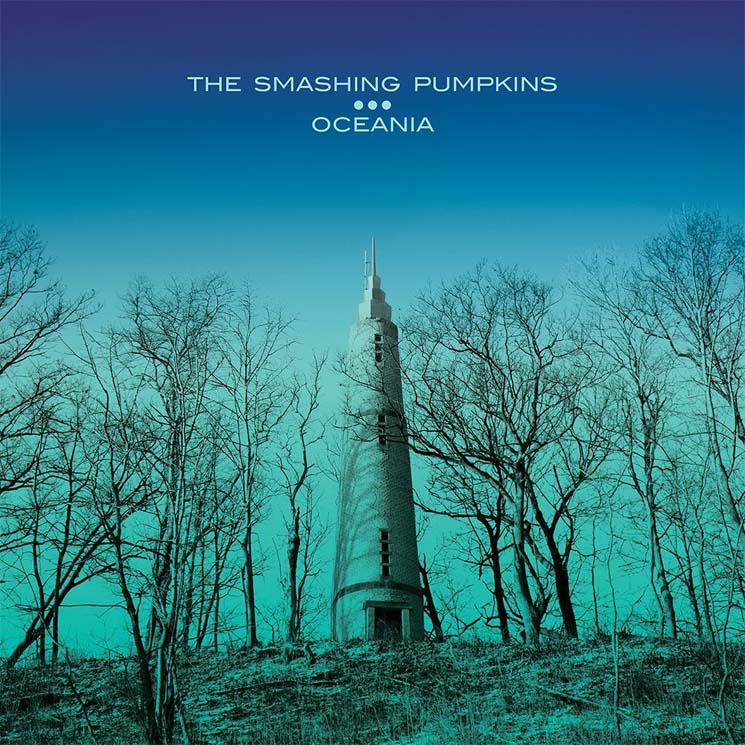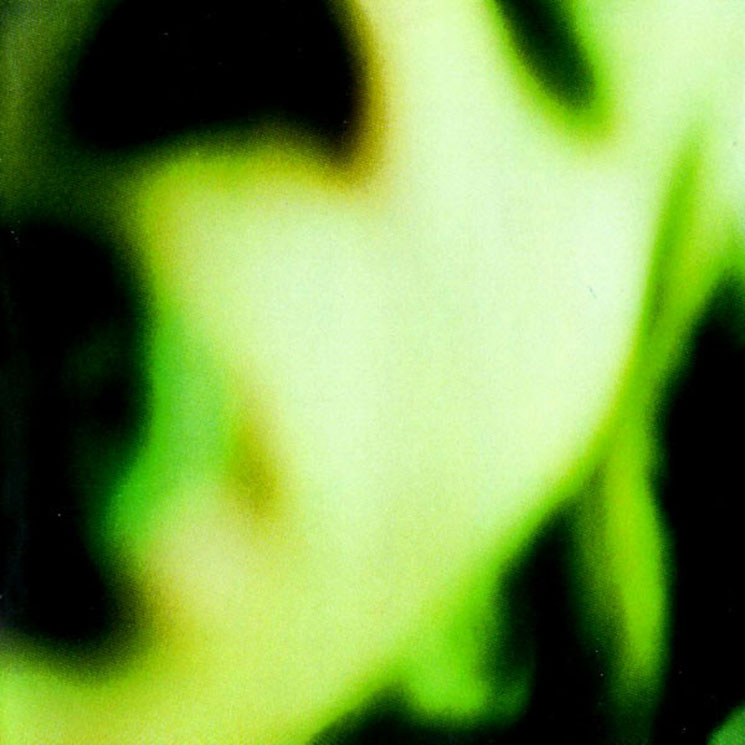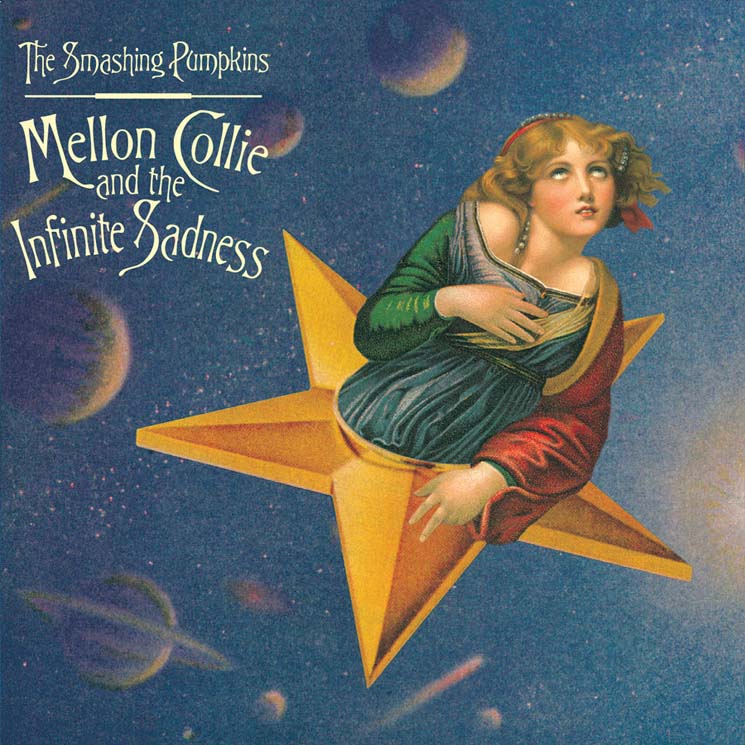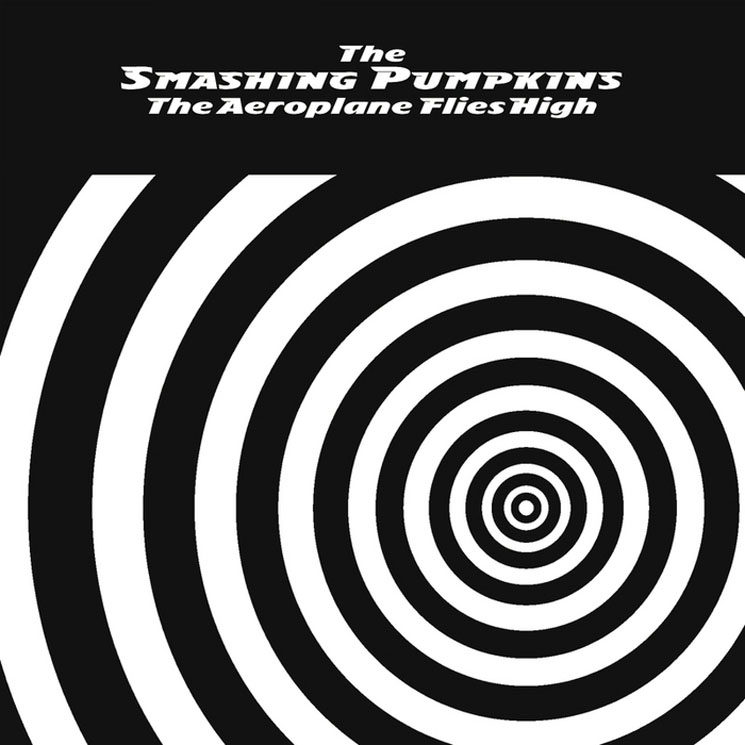Perhaps the greatest obstacle to the Smashing Pumpkins being widely recognized as one of the most vital and innovative rock bands of all time is the public persona that has been cultivated around ringleader Billy Corgan. So let's leave that aside and focus on the magnificent music the band have made in (almost) all of their incarnations. There is a lot of it.
The Smashing Pumpkins were the quintessential alternative rock act. Even as they were launched to success in grunge's final wave with 1993's Siamese Dream, they were already transcending the genre with a level of musicianship and an interest in dynamic experimentation beyond the majority of their peers. And these weird rock outcasts could never be as cool as the other big bands of the era because they survived and persisted.
The second leg of the group's journey has now been going on longer than its first; Jeff Schroeder has been a Pumpkin longer than D'arcy Wretzky was. And, while they haven't reproduced the world-dominating highs of their mid-'90s heyday, the group have continued to evolve and create vital new material while most of their peers have fallen or faded.
With yet another new lease on the group's lifespan coming in the form of a new tour and studio album with original members Jimmy Chamberlin and James Iha back in the fold, join us for a look at the key works in the ongoing legacy of the Smashing Pumpkins.
Essential Albums:
5. Oceania
(2012)

Nobody expected this album to be this damn good, as the first full-length release without drummer Jimmy Chamberlin since their initial reunion left Corgan as the sole original member. Even with the promise of songs like "Freak," from the convoluted and abandoned Teargarden EP series, an album that could stand alongside the Pumpkins' best work nearly 20 years after Siamese Dream wasn't a reasonable expectation.
But Corgan excels at delivering the unreasonable and the chemistry of the musicians that recorded Oceania is undeniable. Corgan's songwriting and guitar work are in peak form, full of skyscraping hooks and indelible melodies. Mike Byrne attacks the drums with the precise ferocity of someone who knows exactly how hard it is to fill Jimmy Chamberlin's shoes, and Nicole Fiorentino's bass work is quite probably the strongest the Pumpkins have put to record. Tracks like "Panopticon," the epic title track and closer "Wildflower" resonate with the majesty and intensity of the band's early work, but also carry a calm maturity that gives the whole endeavour a unique flavour.
4. Machina II/The Friends & Enemies of Modern Music
(2000)

The Pumpkins capped the first phase of their career with a middle finger to the record industry, and an incidentally prescient gesture of goodwill to fans. They released this album for free to sooth the pain of their breakup. When Virgin wouldn't release 2000's Machina as a double album, the band pressed a limited number of Machina II copies and its B-sides, and sent them to members of the online community with instructions to distribute them freely.
This freakier and looser collection sees the Pumpkins treating some of their sharpest hooks and biggest riffs to raw production experiments that would never fly on an official release, but the confrontational approach gives each track an inexorable sonic identity. "Cash Car Star" is an absolute monster of a track, featuring some of the most absurdly beefy drumming Jimmy Chamberlin has ever laid down, with a fantastically simple and effective Corgan riff. With more traditional treatment, "Real Love," "Let Me Give the World to You" or "If There is a God" could have been crossover hits. "Dross" is a syrupy glam-metal stomper that nearly matches the nihilistic swagger of "Zero."
Sequencing that sort of unexpected heaviness alongside beautiful acoustic ballads like "Innosense" and the quirky alt-wave hooks of "Atom Bomb" is what makes for a truly excellent Smashing Pumpkins album. That they had this much A-list material waiting in the wings is a testament to how inspired the band can be when they're unconstrained by expectation.
3. Pisces Iscariot
(1994)

There was a time period when the Smashing Pumpkins' productivity was almost alchemical. The band were so prolific and operating on such a high level of creative inspiration that a collection of B-sides — finished after Siamese Dream — came to be regarded as its followup. It was the original rock version of a low-key mixtape release that's actually incredible in its informal looseness.
Without the pressure of polish, the lesser-seen joyous side of the Pumpkins really shines through. You can hear the fun the band are having on fuzzy psychedelic stompers "Frail and Bedazzled" and "Plume." The B-sides are also where you get to hear both the band at their most aggressive (snarling punk thrasher, "Pissant") and delicate (a breathtaking cover of Fleetwood Mac's "Landslide"). "Blew Away" is arguably James Iha's best song with the band, and certainly the one that feels the most fully integrated into their overall sound, meshing his folkier, country-influenced writing with thick, searing guitar pyrotechnics. Eastern ballad "Obscured" and hypnotic psych-rock epic "Starla" also rank as some of the band's most infectious and enduring work.
2. Siamese Dream
(1993)

Siamese Dream is an inarguably seminal rock album. This is the album that made the modifier "alternative" necessary, rather than just lumping the Smashing Pumpkins in with grunge. Because, yes, it's grungy — "Quiet" and "Cherub Rock" are positively filthy rock songs — but the band couldn't resist tampering with the formula on tracks like vulnerable mega hit ballad "Disarm," the swooning "Luna" and the heartbreaking "Spaceboy," where Corgan and company make great restrained use of the Eastern psychedelics that have always coloured their sound.
It's almost easy to forget how effectively Corgan can write a simple pop hook, with "Today"'s ubiquity, especially on an album that has moody, texturally sophisticated pieces like "Soma" and "Mayonaise" and gargantuan rock beasts like "Geek U.S.A." and "Silverfuck." Siamese Dream is the sound of a unique and potent band utterly hitting their stride, and remains one of the defining albums of the early '90s, pointing to a future for rock after grunge.
1. Mellon Collie and the Infinite Sadness
(1995)

The Smashing Pumpkins designed Mellon Collie and the Infinite Sadness to be their crowning statement on rock music, and it is certainly among the grandest efforts in the pantheon. It's an album unlike any other, perfectly encapsulating a moment where alienation was mainstream and the sound they'd created needed to publicly devour itself and blossom into something new, exploring every potential avenue along the way.
From the opening piano notes of the title track, you know you're in for a special experience conceived with the utmost care. The hits are transcendent anthems for an era rich in possibility, but suspicious that it could, and inevitably must, all come crashing down. Corgan's plaintive optimism peeks through briefly with "Tonight, Tonight," but the album mainly speaks to darker, more complex emotions over its 28 songs spread across two discs.
Not every track will resonate with everyone, but it's remarkable that there really is no filler. Each song has a distinct role to play on the album and together they represent one of the most diverse arrays of styles committed to a single album by a rock band. "Jellybelly," "Here Is No Why" and "Bodies" are monumental, blistering examples of peak alt-rock that sit alongside the quiet beauty of "To Forgive" and "Stumbleine," the heavenly harps of "Cupid de Locke," the epic prog of "Porcelina of the Vast Oceans," "Galapagos" and "Thru the Eyes of Ruby," the gorgeous electro-pop of "Beautiful," the whimsical, sophisticated country-folk of "Lily (My One and Only)," the ferocious thrash metal of "X.Y.U" and the sublime alt-pop of "1979." Mellon Collie is a towering achievement in rock music and one of the last where the excess of the music industry supported a truly bold and innovative work by one of the most creatively fearless and original groups in the business.
What to Avoid:

A lot of Zeitgeist, the Pumpkins' 2007 comeback album is pretty forgettable — at least compared to their own output — and some tracks from the Teargarden EP series are pretty mediocre ("Owata" and "The Fellowship", in particular) but 2014's Monuments to an Elegy is the only album to outright avoid.
Streamlining the band's sound into a more digestible, less distinct package and hiring graceless drummer Tommy Lee was a stunt that didn't pay off. Moreover, the sharp hooks and melodies that Corgan seems to write so effortlessly most of the time show up in very short supply. It's the only time in the Pumpkins' career that it sounds like Corgan was writing an album he thought people wanted to hear, instead of whatever the heck he was truly feeling.
Further Listening:

The Smashing Pumpkins were on such a role musically with Mellon Collie that they released an entire box set of B-sides, which, taken together, would constitute another absolutely killer, if less consistent and thematically cohesive album. The Aeroplane Flies High (1996) contains some of the Pumpkins' best music. "Set the Ray to Jerry" alone is worth the price of admission, but there's a plethora of great tracks and amusing curiosities to dig through.
Adore (1998) is the first album the Pumpkins recorded without Jimmy Chamberlin, following his temporary ouster for drug abuse. Cloaked in the spectre of that dark turn, and the passing of Corgan's mother, Adore is a sombre affair that reaches for a place to take the band that isn't rock. It was a bit jarring at the time, but the forward-thinking use of electronics, mature songcraft and Corgan's newfound vocal confidence has aged well. "To Sheila" and "Behold! The Night Mare" stand among the most gorgeous and emotionally rich recordings the band have made.
Possibly the most unexpectedly excellent area of the Smashing Pumpkins' vast catalogue is the period surrounding 2008's American Gothic EP and the If All Goes Wrong tour documentary. The EP is an excellent return to form after 2007's uneven Zeitgeist ("Bring The Light" is that album's secret weapon) and in true Pumpkins form, If All Goes Wrong is not just a document of the band touring existing material, but an essential album in its own right, featuring a bunch of unique songs ("99 Floors," the insane 30-minute-plus, semi-improvised "Gossamer"), radical reworkings ("The Crying Tree of Mercury") and rarities ("Untitled"). This is also the era that gave us "Superchrist" and "G.L.O.W.," two of the best non-album cuts the band have released. Speaking of, their soundtrack contributions have all been pretty stellar with "Eye" for Lost Highway, "The End is the Beginning is the End" and "The Beginning is the End is the Beginning" for Batman and Robin and "Drown" for Singles back in 1992.
The album that started it all remains one of the great post-'70s psychedelic rock records. Gish (1991) contains much of the genetic material that the core Smashing Pumpkins sound is built on — fluid, bombastic drumming with Eastern-influenced psych-rock drones drenched in swirling guitar effects and dynamic odes to the eternal search for spiritual enlightenment and introspection. "I Am One," "Rhinoceros" and "Snail" are tremendous pieces for a band discovering their sonic identity.
The Smashing Pumpkins' official swan song in 2000, Machina/The Machines of God, has a lot of top notch material — "The Everlasting Gaze," "Stand Inside Your Love," "Age of Innocence," "This Time" and "Glass and the Ghost Children" are everything we love about the Pumpkins — but parts of the album come off a bit stiff and overly clinical.
The Smashing Pumpkins were the quintessential alternative rock act. Even as they were launched to success in grunge's final wave with 1993's Siamese Dream, they were already transcending the genre with a level of musicianship and an interest in dynamic experimentation beyond the majority of their peers. And these weird rock outcasts could never be as cool as the other big bands of the era because they survived and persisted.
The second leg of the group's journey has now been going on longer than its first; Jeff Schroeder has been a Pumpkin longer than D'arcy Wretzky was. And, while they haven't reproduced the world-dominating highs of their mid-'90s heyday, the group have continued to evolve and create vital new material while most of their peers have fallen or faded.
With yet another new lease on the group's lifespan coming in the form of a new tour and studio album with original members Jimmy Chamberlin and James Iha back in the fold, join us for a look at the key works in the ongoing legacy of the Smashing Pumpkins.
Essential Albums:
5. Oceania
(2012)

Nobody expected this album to be this damn good, as the first full-length release without drummer Jimmy Chamberlin since their initial reunion left Corgan as the sole original member. Even with the promise of songs like "Freak," from the convoluted and abandoned Teargarden EP series, an album that could stand alongside the Pumpkins' best work nearly 20 years after Siamese Dream wasn't a reasonable expectation.
But Corgan excels at delivering the unreasonable and the chemistry of the musicians that recorded Oceania is undeniable. Corgan's songwriting and guitar work are in peak form, full of skyscraping hooks and indelible melodies. Mike Byrne attacks the drums with the precise ferocity of someone who knows exactly how hard it is to fill Jimmy Chamberlin's shoes, and Nicole Fiorentino's bass work is quite probably the strongest the Pumpkins have put to record. Tracks like "Panopticon," the epic title track and closer "Wildflower" resonate with the majesty and intensity of the band's early work, but also carry a calm maturity that gives the whole endeavour a unique flavour.
4. Machina II/The Friends & Enemies of Modern Music
(2000)

The Pumpkins capped the first phase of their career with a middle finger to the record industry, and an incidentally prescient gesture of goodwill to fans. They released this album for free to sooth the pain of their breakup. When Virgin wouldn't release 2000's Machina as a double album, the band pressed a limited number of Machina II copies and its B-sides, and sent them to members of the online community with instructions to distribute them freely.
This freakier and looser collection sees the Pumpkins treating some of their sharpest hooks and biggest riffs to raw production experiments that would never fly on an official release, but the confrontational approach gives each track an inexorable sonic identity. "Cash Car Star" is an absolute monster of a track, featuring some of the most absurdly beefy drumming Jimmy Chamberlin has ever laid down, with a fantastically simple and effective Corgan riff. With more traditional treatment, "Real Love," "Let Me Give the World to You" or "If There is a God" could have been crossover hits. "Dross" is a syrupy glam-metal stomper that nearly matches the nihilistic swagger of "Zero."
Sequencing that sort of unexpected heaviness alongside beautiful acoustic ballads like "Innosense" and the quirky alt-wave hooks of "Atom Bomb" is what makes for a truly excellent Smashing Pumpkins album. That they had this much A-list material waiting in the wings is a testament to how inspired the band can be when they're unconstrained by expectation.
3. Pisces Iscariot
(1994)

There was a time period when the Smashing Pumpkins' productivity was almost alchemical. The band were so prolific and operating on such a high level of creative inspiration that a collection of B-sides — finished after Siamese Dream — came to be regarded as its followup. It was the original rock version of a low-key mixtape release that's actually incredible in its informal looseness.
Without the pressure of polish, the lesser-seen joyous side of the Pumpkins really shines through. You can hear the fun the band are having on fuzzy psychedelic stompers "Frail and Bedazzled" and "Plume." The B-sides are also where you get to hear both the band at their most aggressive (snarling punk thrasher, "Pissant") and delicate (a breathtaking cover of Fleetwood Mac's "Landslide"). "Blew Away" is arguably James Iha's best song with the band, and certainly the one that feels the most fully integrated into their overall sound, meshing his folkier, country-influenced writing with thick, searing guitar pyrotechnics. Eastern ballad "Obscured" and hypnotic psych-rock epic "Starla" also rank as some of the band's most infectious and enduring work.
2. Siamese Dream
(1993)

Siamese Dream is an inarguably seminal rock album. This is the album that made the modifier "alternative" necessary, rather than just lumping the Smashing Pumpkins in with grunge. Because, yes, it's grungy — "Quiet" and "Cherub Rock" are positively filthy rock songs — but the band couldn't resist tampering with the formula on tracks like vulnerable mega hit ballad "Disarm," the swooning "Luna" and the heartbreaking "Spaceboy," where Corgan and company make great restrained use of the Eastern psychedelics that have always coloured their sound.
It's almost easy to forget how effectively Corgan can write a simple pop hook, with "Today"'s ubiquity, especially on an album that has moody, texturally sophisticated pieces like "Soma" and "Mayonaise" and gargantuan rock beasts like "Geek U.S.A." and "Silverfuck." Siamese Dream is the sound of a unique and potent band utterly hitting their stride, and remains one of the defining albums of the early '90s, pointing to a future for rock after grunge.
1. Mellon Collie and the Infinite Sadness
(1995)

The Smashing Pumpkins designed Mellon Collie and the Infinite Sadness to be their crowning statement on rock music, and it is certainly among the grandest efforts in the pantheon. It's an album unlike any other, perfectly encapsulating a moment where alienation was mainstream and the sound they'd created needed to publicly devour itself and blossom into something new, exploring every potential avenue along the way.
From the opening piano notes of the title track, you know you're in for a special experience conceived with the utmost care. The hits are transcendent anthems for an era rich in possibility, but suspicious that it could, and inevitably must, all come crashing down. Corgan's plaintive optimism peeks through briefly with "Tonight, Tonight," but the album mainly speaks to darker, more complex emotions over its 28 songs spread across two discs.
Not every track will resonate with everyone, but it's remarkable that there really is no filler. Each song has a distinct role to play on the album and together they represent one of the most diverse arrays of styles committed to a single album by a rock band. "Jellybelly," "Here Is No Why" and "Bodies" are monumental, blistering examples of peak alt-rock that sit alongside the quiet beauty of "To Forgive" and "Stumbleine," the heavenly harps of "Cupid de Locke," the epic prog of "Porcelina of the Vast Oceans," "Galapagos" and "Thru the Eyes of Ruby," the gorgeous electro-pop of "Beautiful," the whimsical, sophisticated country-folk of "Lily (My One and Only)," the ferocious thrash metal of "X.Y.U" and the sublime alt-pop of "1979." Mellon Collie is a towering achievement in rock music and one of the last where the excess of the music industry supported a truly bold and innovative work by one of the most creatively fearless and original groups in the business.
What to Avoid:

A lot of Zeitgeist, the Pumpkins' 2007 comeback album is pretty forgettable — at least compared to their own output — and some tracks from the Teargarden EP series are pretty mediocre ("Owata" and "The Fellowship", in particular) but 2014's Monuments to an Elegy is the only album to outright avoid.
Streamlining the band's sound into a more digestible, less distinct package and hiring graceless drummer Tommy Lee was a stunt that didn't pay off. Moreover, the sharp hooks and melodies that Corgan seems to write so effortlessly most of the time show up in very short supply. It's the only time in the Pumpkins' career that it sounds like Corgan was writing an album he thought people wanted to hear, instead of whatever the heck he was truly feeling.
Further Listening:

The Smashing Pumpkins were on such a role musically with Mellon Collie that they released an entire box set of B-sides, which, taken together, would constitute another absolutely killer, if less consistent and thematically cohesive album. The Aeroplane Flies High (1996) contains some of the Pumpkins' best music. "Set the Ray to Jerry" alone is worth the price of admission, but there's a plethora of great tracks and amusing curiosities to dig through.
Adore (1998) is the first album the Pumpkins recorded without Jimmy Chamberlin, following his temporary ouster for drug abuse. Cloaked in the spectre of that dark turn, and the passing of Corgan's mother, Adore is a sombre affair that reaches for a place to take the band that isn't rock. It was a bit jarring at the time, but the forward-thinking use of electronics, mature songcraft and Corgan's newfound vocal confidence has aged well. "To Sheila" and "Behold! The Night Mare" stand among the most gorgeous and emotionally rich recordings the band have made.
Possibly the most unexpectedly excellent area of the Smashing Pumpkins' vast catalogue is the period surrounding 2008's American Gothic EP and the If All Goes Wrong tour documentary. The EP is an excellent return to form after 2007's uneven Zeitgeist ("Bring The Light" is that album's secret weapon) and in true Pumpkins form, If All Goes Wrong is not just a document of the band touring existing material, but an essential album in its own right, featuring a bunch of unique songs ("99 Floors," the insane 30-minute-plus, semi-improvised "Gossamer"), radical reworkings ("The Crying Tree of Mercury") and rarities ("Untitled"). This is also the era that gave us "Superchrist" and "G.L.O.W.," two of the best non-album cuts the band have released. Speaking of, their soundtrack contributions have all been pretty stellar with "Eye" for Lost Highway, "The End is the Beginning is the End" and "The Beginning is the End is the Beginning" for Batman and Robin and "Drown" for Singles back in 1992.
The album that started it all remains one of the great post-'70s psychedelic rock records. Gish (1991) contains much of the genetic material that the core Smashing Pumpkins sound is built on — fluid, bombastic drumming with Eastern-influenced psych-rock drones drenched in swirling guitar effects and dynamic odes to the eternal search for spiritual enlightenment and introspection. "I Am One," "Rhinoceros" and "Snail" are tremendous pieces for a band discovering their sonic identity.
The Smashing Pumpkins' official swan song in 2000, Machina/The Machines of God, has a lot of top notch material — "The Everlasting Gaze," "Stand Inside Your Love," "Age of Innocence," "This Time" and "Glass and the Ghost Children" are everything we love about the Pumpkins — but parts of the album come off a bit stiff and overly clinical.
